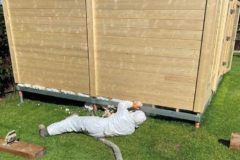 The Omar Group’s Richard Sigsworth answers prospective park home owners’ buying questions…
The Omar Group’s Richard Sigsworth answers prospective park home owners’ buying questions…
Q. I’ve noticed damp and mould in my park home – what can I do about it?
Richard says: In the same way that damp can occur in a traditional brick built property, it can also occur in park homes; a lack of ventilation tends to be one of the main causes for this.
In November 2015 the British Standard (BS 3632) to which park homes (and some lodges) are built was updated. In addition to the well documented improvements to insulation, the new standard also now requires better cross-flow ventilation to improve air quality and the inclusion of a vapour control layer has been moved from an advisory note to a requirement (a vapour control layer helps to protect a home from the consequences of condensation). These changes mean that newer park homes are less likely to experience issues with damp and mould.
Should you have an existing case of mould, a mild cleaning solution can be used to treat the area. In addition, a dehumidifier or dry air unit may help to reduce humidity levels.
Specialist anti-mould paints can also be used, post-cleaning, to deter any occurrences.
Here are a few simple steps you can take to prevent the occurrence of damp or mould:
● Leave trickle vents that have been fitted to windows and doors open to allow air to move around freely (if left closed, cold air from outside and warm centrally heated air within the property will combine and create moisture).
● Avoid covering radiators as this can prevent air circulation.
● Use extractor fans in bathrooms and kitchens; closing internal doors and opening windows will also assist with clearing steam and cooking smells!
● Don’t forget to check gutters and drains are clear of debris as blocked gutters could cause water to seep into your home causing damp.
● Dry laundry outside if at all possible.


